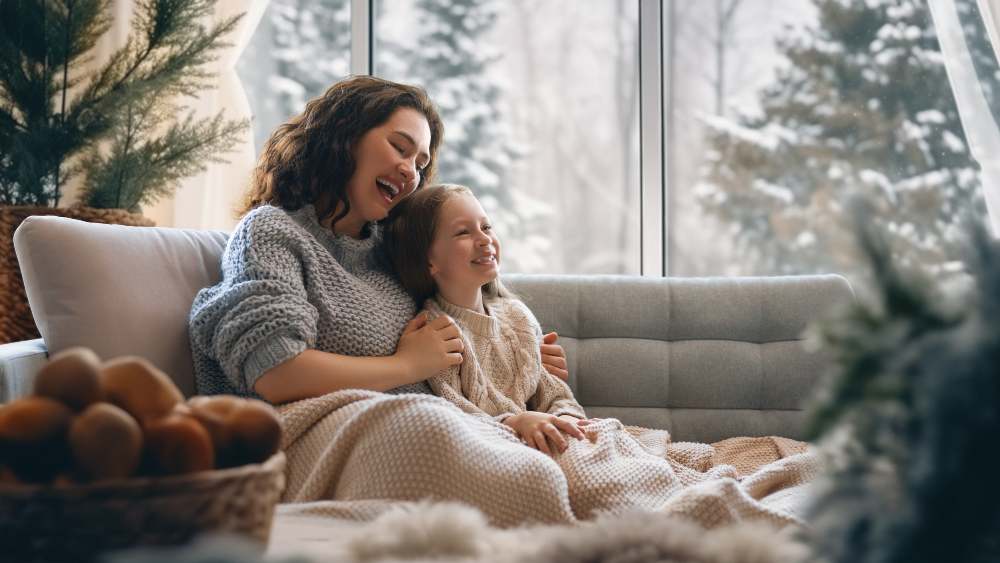
Key Takeaways
- Set your thermostat between 68°F and 70°F when you’re home in winter.
- When going on vacation, set your thermostat between 55°F and 65°F to prevent pipes from freezing.
- To lower your heating cost, opt for a smart thermostat, seal air leaks, and get an energy audit.
Heating, as a major energy consumer in your home, constitutes approximately 29% of your utility bill. Thus, the conventional approach of cranking up the thermostat to combat the winter chill is no longer a viable option. This leaves many homeowners wondering how to strike the perfect balance between comfort and energy efficiency.
This guide will determine what temperature to set the thermostat in the winter for a toasty home environment that won’t drive up your bills. Plus, it offers insights into effective strategies to manage your heating bills.
- Optimal Thermostat Temperature Setting in Winter
- What Temperature to Set Your Thermostat in Winter at Night?
- What Temperature to Set Thermostat When on Vacation in Winter?
- Ideal Winter Temperature for Pets
- Ideal Winter Temperature for Plants
- Should You Keep Your Thermostat at a Constant Temperature in Winter Season?
- Tips to Lower Your Heating Bills
- The Takeaway
Optimal Thermostat Temperature Setting in Winter
According to guidelines from the US Department of Energy, it is recommended to set your thermostat around 68F to 70F. Maintaining a lower indoor temperature helps your home lose heat at a slower rate compared to a higher temperature setting, leading to energy savings in the long run.
If this range feels too chilly for you, lower the temperature gradually to give yourself time to adapt instead of making abrupt changes. During this adjustment period, consider wearing layers, putting on warm socks, and keeping a cozy blanket nearby to stay comfortable.
Energy Efficiency When You Are Away
To further enhance efficiency, you should also schedule eight hours daily, during which you setback your thermostat by 7F to 10F from your usual settings. Following this routine will result in potential yearly savings of up to 10%. You can do this when you are away at work, and your house is empty. When you return home, you can raise it to your comfortable level.
Related: Energy-Efficient Thermostat Settings to Maximize Savings & Comfort
Perfect Temperature Balance
Considering the high energy prices, you may be tempted to lower your home temperature even below 60F and compensate by layering up in warm clothes. However, it’s not advisable to set the temperature too low due to safety concerns. The World Health Organization states that maintaining indoor temperatures between 64F and 75F is necessary for overall well-being. For children, the elderly, or those with health issues, it’s recommended not to let the temperature drop below 68F.
Related: A Complete Guide to Finding the Perfect Thermostat Settings for Your Home
What Temperature to Set Your Thermostat in Winter at Night?
The ideal sleeping temperature is between 60F and 68F. This suggested range is considered optimal because it aligns with the natural decrease of your core body temperature at night. Lowering your thermostat at night can complement your body’s natural temperature fluctuations by signaling that it’s time for sleep.
What Temperature to Set Thermostat When on Vacation in Winter?

If you are wondering what temperature to set the thermostat in winter when away from home, then the ideal range is 55F to 60F. You can consider going as low as 45F to reduce your energy costs if you live in an area that experiences mild winter and the risk of freezing pipes is minimal. Here’s a complete guide on what temperature to keep in your house while on vacation.
It’s worth noting that the size of your house plays a role in these settings. For larger homes, it’s recommended to set a slightly higher temperature to ensure every nook and cranny with plumbing pipes stays above freezing. Some mini-split heat pumps have a freeze protection mode, which allows your heating to run at a minimum temperature without consuming a lot of energy. You can operate this mode remotely using your phone by pairing your mini-split with a mini-split thermostat.
Your best choice to make any mini-split, window,
or portable AC smart. Enhance your comfort and savings.

Smart thermostats like Cielo Smart Thermostats offer a convenient feature known as vacation mode. This allows you to set specific heating and cooling settings for the duration of your trip. During this period, your HVAC unit operates within the defined parameters, ensuring a safe temperature for your home.
Note: Never shut down your heating system when going away. If the outside weather dips too low, your pipes can freeze, expand, and burst, leading to flooding.
Ideal Winter Temperature for Pets
A comfortable winter temperature for your dog involves considering factors such as breed, age, health, coat type, and weight. Larger dogs with thicker coats generally find a temperature range of 69-70F ideal. On the other hand, smaller dogs or those with thinner coats may prefer a slightly warmer environment, typically ranging from 73F to 75F.
Related: Top 12 Heated Dog Houses to Create a Cozy Retreat for Your Furry Friend
Cats are prone to getting cold easily as compared to humans. It’s common to observe cats seeking warmth in spots like sunlit areas, radiator covers, or warm laps. Kittens and senior cats, as well as those who are unwell, underweight, or belong to breeds originating from warmer climates, are more vulnerable to cold.
In winter, aim for a temperature range of 60-68F for your feline companions. For kittens, a temperature between 78F and 80F provides just the comfort they need.
Related: Pet Comfort for Dogs and Cats – Your Top Questions Answered
Ideal Winter Temperature for Plants
Different houseplants have varying temperature requirements based on their species. Generally, indoor houseplants thrive in temperatures ranging from 70-80F during the day and 65-70F at night. Tropical plants such as monstera, spider plants, and pothos are not winter-hardy and may not survive temperatures below 50F. Cacti and succulents are more resilient to the cold; they can withstand temperatures as low as 40F. Here is a complete guide on how to maintain the temperature of your plants like a pro.
Should You Keep Your Thermostat at a Constant Temperature in Winter Season?
Keeping your home at the same temperature and running your HVAC system continuously, especially when you are away for extended periods, can result in unnecessary strain on the unit. This, in turn, can lead to frequent HVAC repairs and high energy bills. Thus, it’s advisable to adjust your thermostat settings as necessary to optimize energy usage.
Tips to Lower Your Heating Bills
Here are some top tips for keeping your heating bills low while staying warm all winter long.
-
Invest in a Smart Thermostat

Making constant temperature adjustments can be quite tiring. This is where smart thermostats or smart AC controllers can help. These devices allow you to monitor home temperature and humidity in real-time through your smartphone, providing the flexibility to make adjustments remotely. This also leads to cost savings as your unit never runs unnecessarily.
Smart climate control devices come with features such as smart scheduling and energy usage tracking that not only enhance energy efficiency but also contribute to a more comfortable living environment. Smart thermostats like Cielo Smart Thermostats can utilize geofencing capabilities to automatically lower the temperature when you enter or leave your set location, as well as adjust the indoor temperature based on outside weather conditions.
Related: Cielo Smart Thermostat Energy Savings: Top Ways to Reduce the Impact of Rising Energy Prices
Equip your HVAC system with smart features and achieve the perfect balance between comfort & savings.
Learn more
-
Inspect Your Heating System Before Winter
Have your heating unit checked out before the chilly weather sets in. Furthermore, you should follow a thorough HVAC maintenance checklist to ensure that your heating system keeps functioning optimally throughout the season. You should clean your air filters every 2 weeks and replace them every 3-4 months. Also, ensure that all vents are unobstructed, keeping them clear of drapes, bookshelves, and rugs that could impede proper airflow.
Related: Stay on Top of Your HVAC Maintenance Needs in 2025
-
Seal Air Leaks
Minimize the entry of cold air into your home by looking for drafty windows and sealing air leaks. Add weather-stripping around doors to keep warm air in and cold air out. Also, use caulking to seal cracks and gaps in these areas. Combat cold air seeping under doors by using a draft stopper or a simple rolled-up towel.
-
Check Your Thermostat Placement
In conjunction with adhering to temperature guidelines, you can enhance energy efficiency by strategically placing your thermostat. Avoid drafty areas such as near vents, doors, or windows, and steer clear of direct sunlight exposure, as these conditions might trigger the thermostat unnecessarily. The ideal thermostat placement is an interior wall in a frequently used area of your home.
-
Add Individual Room Heating Options
Room units such as mini-split, window, and portable heat pumps are becoming more popular in the US. These units are considered more energy efficient as they do not have any ducts that can contribute to energy loss. Moreover, instead of heating the whole home with central units, you can only heat individual rooms as needed, thus significantly reducing energy usage.
You can also opt for small heating appliances such as space heaters for targeted warmth. They are designed to heat specific areas or small rooms in your home. Thanks to the incorporation of built-in safety features, modern space heaters are considerably safer than their predecessors. You can get one that automatically turns off in case of tipping over, overheating, or being left on for an extended period.
Related: The Ideal Room Temperature for Every Situation & 7 Ways to Maintain It!
-
Get an Energy Audit
The energy audit provides a detailed assessment of your home’s energy consumption. It evaluates how much energy your appliances consume and identifies problems such as inadequate insulation or the need for an HVAC unit replacement. Subsequently, the expert performing the audit can formulate a plan for you to rectify these issues, ultimately leading to lower energy bills.
Related: Is an HVAC Energy Audit Worth Going For?
-
Check for Tax Incentives and Rebates
The Inflation Reduction Act of 2022 offers federal tax credits and deductions to enable Americans to enhance the energy efficiency of their homes and buildings. These incentives aim to facilitate the transition to energy-efficient products. For instance, by upgrading your older heating system to a modern heat pump unit, you can claim 30% of the project cost (including equipment and installation, up to $2000).
Furthermore, many utility companies are providing attractive rebate programs to encourage customers to switch to energy-saving devices. For example, investing in an approved smart thermostat may entitle you to a refund of up to 50% of the purchase price from your utility company. Look over the rebate guidelines of your utility company, as the amount of incentive offered varies for different companies. Check out the exclusive rebates offered on Cielo Smart Thermostats!
Related: Unlock the Potential of Cielo Linked & Enjoy Rebates with MassSave
The Takeaway
Finding what temperature to set the thermostat in winter requires striking a balance between comfort and energy efficiency. The recommended temperature range is 68F to 70F when your home is occupied. You can further lower this by 7-10 degrees when you are away or sleeping to save more on bills. Moreover, regularly monitoring and tweaking your thermostat settings, utilizing smart technologies, and adopting energy-efficient habits all contribute to a comfortable and cost-effective winter heating plan.








